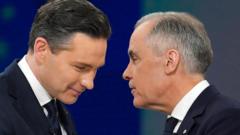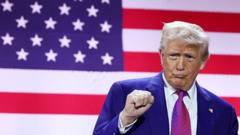As the election approaches, the political scene in Canada is witnessing a remarkable turnaround, with leadership tensions and voter sentiments shifting dramatically.
Canada’s Political Landscape Shifts Dramatically Ahead of Election

Canada’s Political Landscape Shifts Dramatically Ahead of Election
In a closely watched race, Canadian political dynamics have drastically changed as voters head to the polls.
In Vaughan, Ontario, an enthusiastic rally revealed the palpable energy surrounding the election campaign. Liberal leader Mark Carney faced a disdainful crowd when he warned of the existential threats posed by US President Donald Trump, compelling attendees to boldly remind him of their allegiance to a standalone Canada. The fervor of nationalism was similarly echoed at a Conservative rally, where Pierre Poilievre rallied supporters under the banner "Bring it Home," directing attention to the current government’s management of the economy amidst external threats.
As the election date nears, the narrative is defined largely by reactivity to Trump's policies and declarations. Conservative leader Poilievre, acknowledging dissatisfaction with the Liberal government, is running on a platform critical of what he calls a "Lost Liberal decade” and pledges to rejuvenate the Canadian economy. However, in a political twist, Carney's emergence as a prominent candidate has created unexpected momentum, countering earlier predictions of Conservative dominance.
With Trump's presidency looming large over the campaign, Carney has found his footing as a steady leader, having previously navigated economic turbulence during his tenure as the governor of Canada's central bank. His calm demeanor has attracted disenchanted Liberal voters—those turned off by Trudeau's legacy—and positioned him as a viable alternative in reclaiming power for the Liberals.
Yet, not all see Carney’s rise as a benefit; skepticism persists among some voters who question whether his leadership would bring substantive change. Nonetheless, public opinion appears to be shifting, fueled by fears of potential US annexation rhetoric and tariff threats, as Carney’s strategic approach has begun to resonate with the electorate.
In a political landscape where sentiments and allegiances are fluid, the final moments of campaigning have escalated tensions—both parties are striving to capture a significant share of the public vote as third-party candidates risk losing their standing. Moreover, simplistic narratives bound by complex regional issues of climate, immigration, and reconciliation threaten to unravel amidst a focus on economic competitiveness.
As both candidates make their closing arguments, the stakes have never been higher, with votes on Monday likely to reshape the very fabric of Canadian governance.
As the election date nears, the narrative is defined largely by reactivity to Trump's policies and declarations. Conservative leader Poilievre, acknowledging dissatisfaction with the Liberal government, is running on a platform critical of what he calls a "Lost Liberal decade” and pledges to rejuvenate the Canadian economy. However, in a political twist, Carney's emergence as a prominent candidate has created unexpected momentum, countering earlier predictions of Conservative dominance.
With Trump's presidency looming large over the campaign, Carney has found his footing as a steady leader, having previously navigated economic turbulence during his tenure as the governor of Canada's central bank. His calm demeanor has attracted disenchanted Liberal voters—those turned off by Trudeau's legacy—and positioned him as a viable alternative in reclaiming power for the Liberals.
Yet, not all see Carney’s rise as a benefit; skepticism persists among some voters who question whether his leadership would bring substantive change. Nonetheless, public opinion appears to be shifting, fueled by fears of potential US annexation rhetoric and tariff threats, as Carney’s strategic approach has begun to resonate with the electorate.
In a political landscape where sentiments and allegiances are fluid, the final moments of campaigning have escalated tensions—both parties are striving to capture a significant share of the public vote as third-party candidates risk losing their standing. Moreover, simplistic narratives bound by complex regional issues of climate, immigration, and reconciliation threaten to unravel amidst a focus on economic competitiveness.
As both candidates make their closing arguments, the stakes have never been higher, with votes on Monday likely to reshape the very fabric of Canadian governance.




















